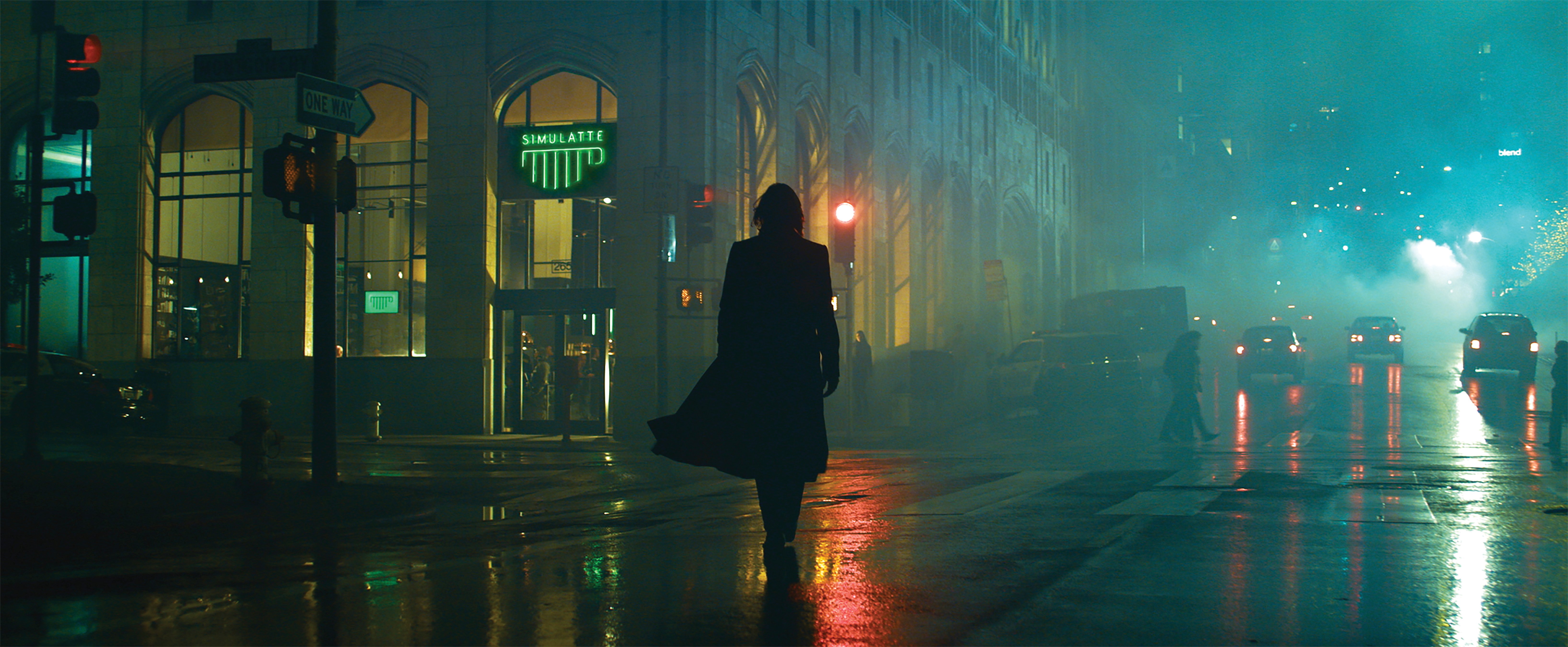
The Matrix Resurrections: Back to the Matrix
John Toll, ASC and Daniele Massaccesi split cinematography duties on Lana Wachowski’s return to the groundbreaking franchise.
It’s time to take the red pill again. Or maybe the blue one. Actually — both.
The Matrix Resurrections revives the vast simulated world last seen 18 years ago when The Matrix Revolutions closed out a groundbreaking trilogy about humans fighting their AI enslaver. As the new film opens, Thomas Anderson (Keanu Reeves) is a quiet, reserved and quite a famous videogame developer, known best for his cultural-touchstone creation called “The Matrix.” He lives in San Francisco, has a psychoanalyst (Neil Patrick Harris) he’s been seeing since a recent breakdown and pops blue pills to stay anchored. He admires a woman named Tiffany (Carrie-Anne Moss) from afar, though he hasn’t had the nerve to speak to her. And he’s been noticing some strange glitches in a test environment he’s been coding for his new game.
“I knew Lana was working on the script — then all of a sudden it was, ‘Okay, we’re going to do it.’”
— John Toll, ASC
With the sudden appearance of blue-haired rebel Bugs (Jessica Henwick), as well as a digital reimagining of his old mentor Morpheus (Yahya Abdul-Mateen II), Anderson comes to realize that his name is really Neo, and “Tiffany” is really Trinity — his former love and trusted ally in the war to free humanity — and that the Matrix is very real. When Morpheus offers up a red pill, the hero’s mind is fully reopened to the true condition of his species, and the struggle begins anew.
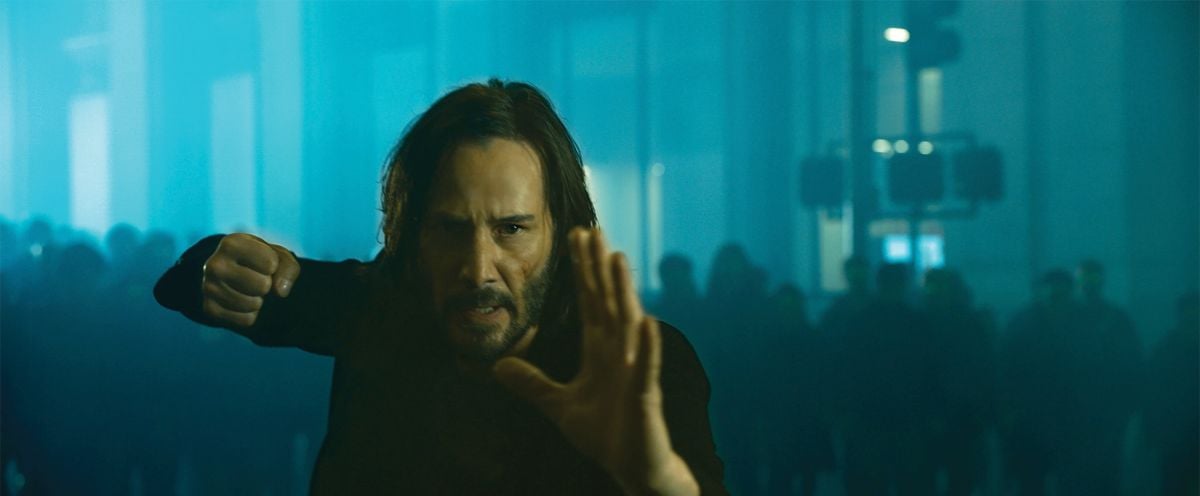
The films of the original trilogy (the first two of which — The Matrix and The Matrix Reloaded — AC covered in April ’99 and June ’03, respectively) were directed by sisters Lana and Lilly Wachowski, but this time Lana single-handedly took the helm, co-writing the script with David Mitchell and Aleksandar Hemon. To shoot the feature, Wachowski tapped two-time Academy Award winner John Toll, ASC (Legends of the Fall, Braveheart), who, along with his crew, have become the director’s go-to collaborators. The three prior Matrix films were shot by cinematographer Bill Pope.
Toll and A-camera/Steadicam operator Daniele Massaccesi first worked with Wachowski on the time-jumping drama Cloud Atlas, followed by the sci-fi epic Jupiter Ascending (AC Feb. ’15) and the Netflix series Sense8. First AC Chad Rivetti, gaffer Jarred Waldron and DIT Ethan Phillips came onboard for Sense8 and continued on Resurrections, joined by key grip Herb Ault.
“We had heard about the possibility of a new Matrix feature film, but it wasn’t definite,” Toll says. “I knew Lana was working on the script — then all of a sudden it was, ‘Okay, we’re going to do it.’”
“I felt the pressure of making a movie that would fit with the three earlier Matrix films.”
— A-camera/Steadicam operator Daniele Massaccesi, upon being asked to take over as director of photography

Massaccesi, who is primarily based in Rome, ended up taking on an expanded role when production was impacted by Covid-19. After the crew wrapped the first leg of the shoot in San Francisco — covering the beginning and end of the film — the production relocated to Studio Babelsberg in Berlin starting in March 2020, but then was delayed due to the pandemic and did not resume until August.
“When a production Covid hiatus was called in Berlin, I came home to California,” Toll says. “These were the early days of Covid. While at home, personal commitments made it difficult for me to continue working an indefinite schedule in Europe. So, I asked to leave the film. Everyone was very understanding. Lana asked Daniele to finish as director of photography, and this had my wholehearted support. Daniele was long overdue to make the move to director of photography. Gaffer Jarred Waldron and the rest of the American crew had a terrific working relationship with Daniele and Lana, so it was the best possible solution for a seamless transition to that type of change.”
Massaccesi embraced the challenge. “The Matrix is one of those movies I keep in my bag and am always happy to watch,” he says. “So, when they first asked me to be involved, I was like, ‘Yes, I’m doing it!’ And then when John left and Lana asked me to finish as DoP, I was very excited — and nervous. I felt the pressure of making a movie that would fit with the three earlier Matrix films.”
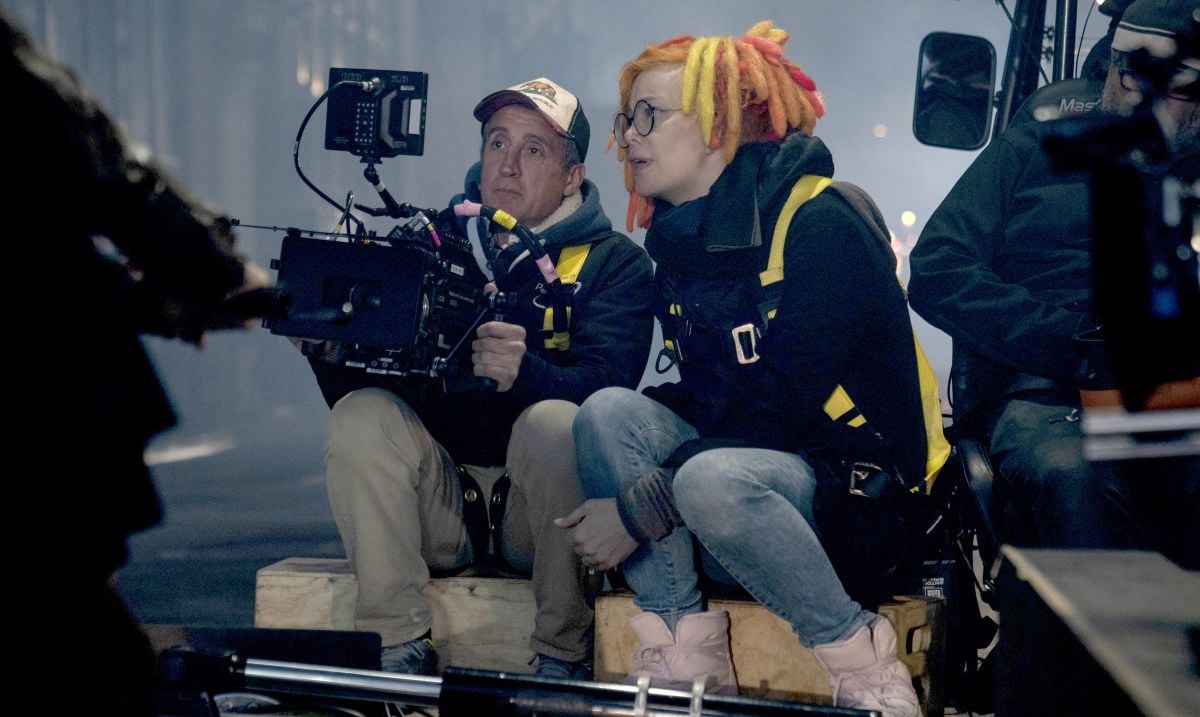
The crew had its working methods down pat. “On Sense8 we had traveled and worked together all over the world,” says Toll, who received the ASC Lifetime Achievement Award in 2016. “At one point I lost count, but we worked in more than 12 different countries on four continents, plus Iceland and India. On that project it was a small key group — Daniele, Jarred and I, along with 1st AC Chad Rivetti, key grip Art Bartels and DIT Ethan Phillips, augmented with local crew members everywhere we worked. So, we were used to working together, at times in an improvised fashion, rather than [with] strict delegation of departmental structure. Jumping in and getting the work done was the priority. We were very comfortable working this way.”
Massaccesi operated nearly the entire film on the Steadicam, save for the odd crane shot — carrying the camera all day. Instead of staying at a fixed monitor, Wachowski opted to move along with Massaccesi while watching the scene on the Steadicam monitor. The director also preferred to be able to adjust the zoom lens herself, either in-shot or between takes, so a zoom remote was attached to the back of Massaccesi’s vest with Velcro. In addition, so Wachowski could also see what B camera was shooting, an iPad with a battery pack was attached with Velcro to the back of the vest as well.
The cinematographer notes that he preferred the B-camera monitor’s placement on his back, and thus out of sight, so as “not to get confused [while] doing my shot. I’ve had enough experience as an operator to figure out what [B-camera operator] Kirk [Gardner] was doing, and he would always tell me if there was a problem. DIT Ethan Phillips was at the monitor overseeing the exposure for both of us.”
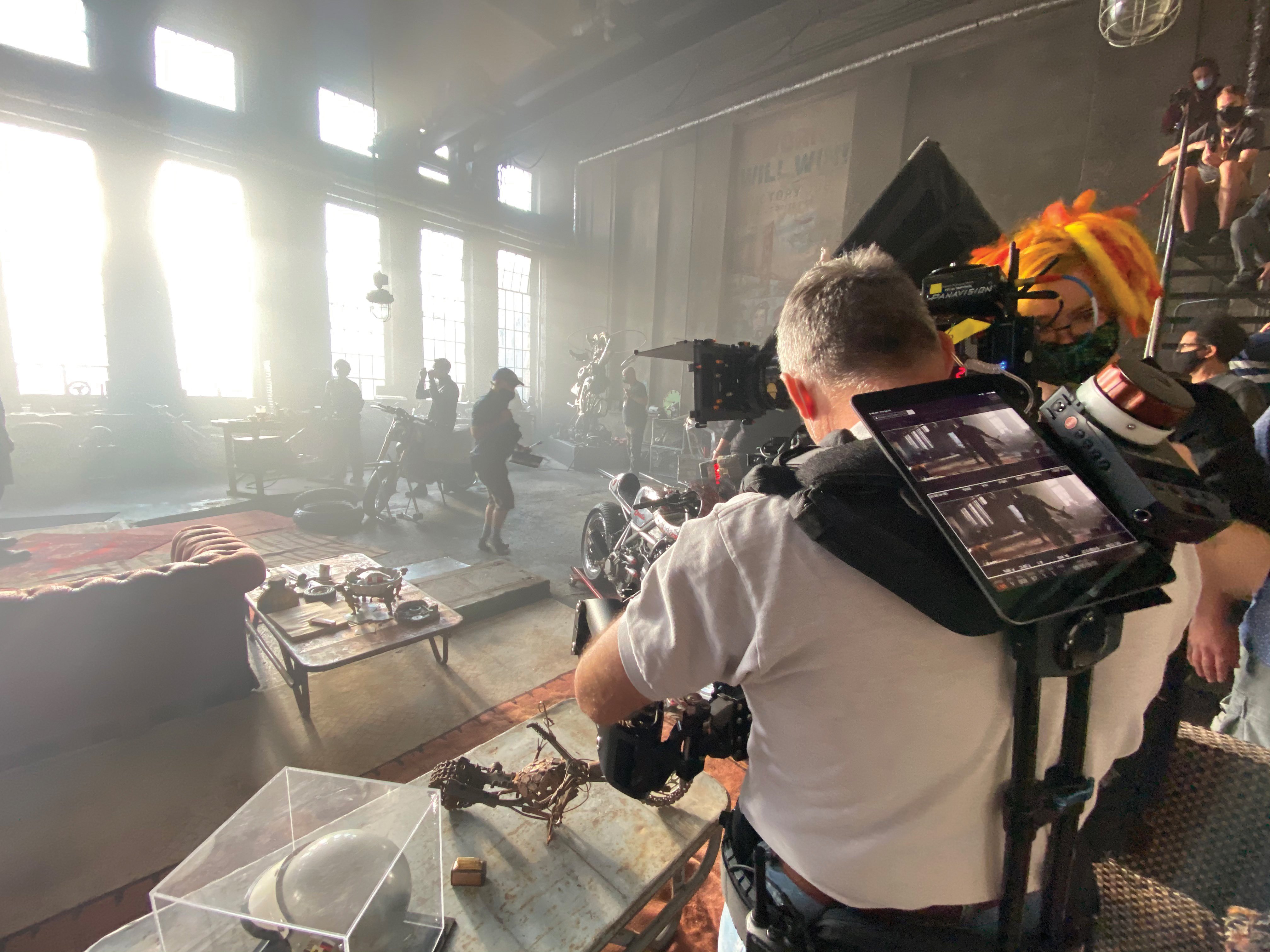
by Wachowski.
Adds 1st AC Rivetti, “For the zoom-control system, we used a Tilta Nucleus-M — [chosen] because it is small and lightweight.” The filmmakers generally eschewed mid-take zooms, though they did use the technique “a couple of times to enhance a kick or a punch — what [Lana] called ‘power zooms,’” Massaccesi says. “[With the backpack rig] we basically created a small control room on set, giving Lana all the tools.
“We shot all of Sense8 that way,” he continues. “Lana was with me, looking at my monitor. She found the fact that she could be on set very appealing. She could whisper in my ear or indicate without words that she wanted to go right or left or move forward. She wanted to keep doing that on The Matrix Resurrections. She could be right there with the actors, immediately giving them direction without losing energy and momentum.”
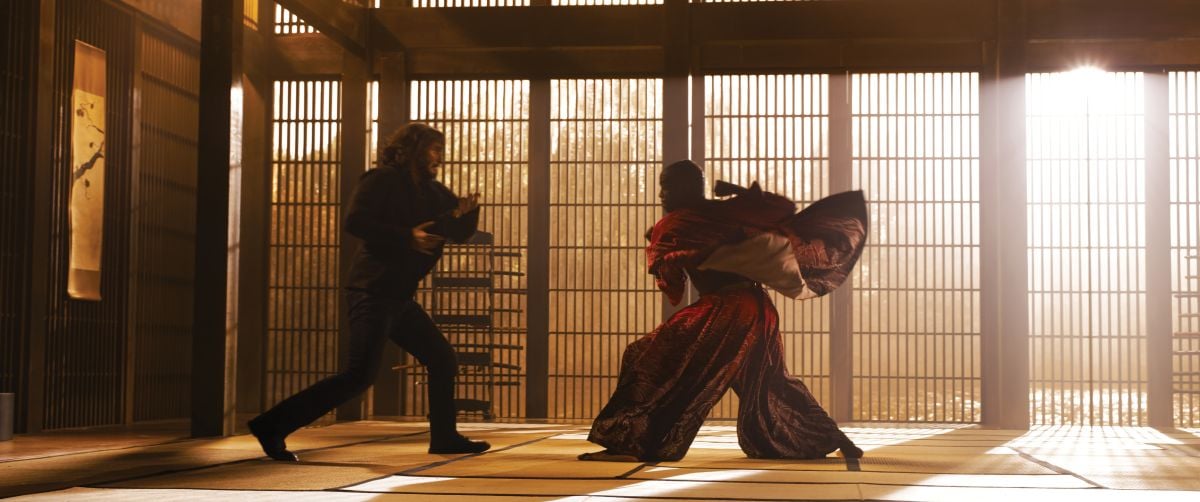
“The new Matrix was approached as a fresh idea,” Toll says. “Obviously, the history of the earlier films was the foundation of the new story, but the new film had a life separate from them. These were the same characters, but it was not a direct extension of the original story.”
Massaccesi adds that when the original films were made, monochrome computer screens with green type were still a relatively recent memory, which is why there was a green tint to scenes that took place within the computer-generated world of the Matrix. “But computers aren’t just green anymore, so we’ve stepped away from that,” he says. “Lana wanted the look to be more natural. She told me, ‘Forget the other movies. We’re doing something different.’” Yet they did seek to distinguish looks in and out of the Matrix. “We went more colorful and softer in the world within the Matrix, whereas ‘real life’ outside the Matrix is hard and cold and contrasty. It takes a lot to take the red pill and deal with the reality outside of the Matrix.”
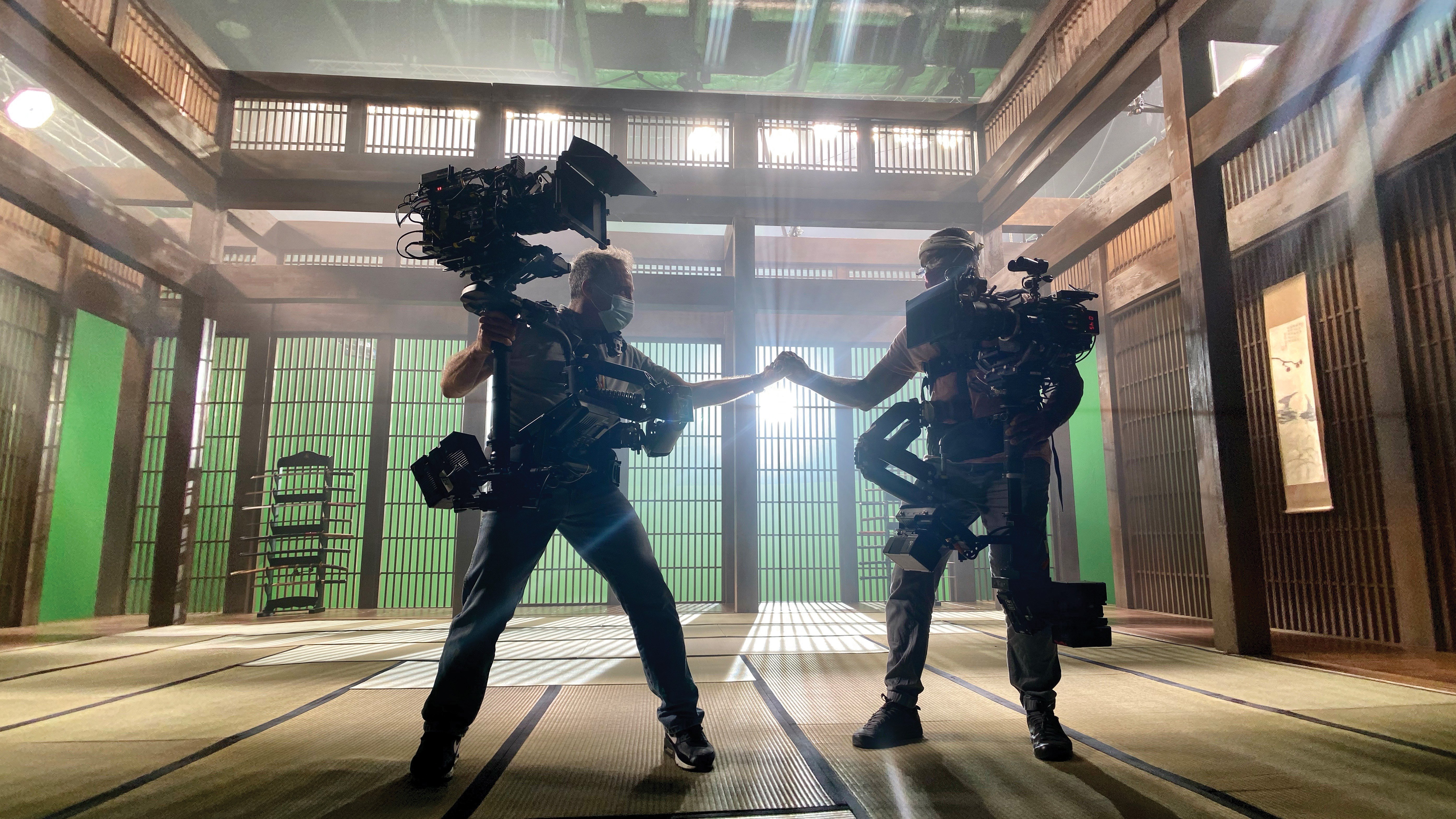
The move to digital capture was another new development for the series. On Resurrections, the filmmakers primarily used the Red Ranger Monstro system, shooting mostly in 6K full format and in 8K for wide shots. They usually ran two cameras — with Mick Froehlich operating B camera in San Francisco and Gardner in Berlin — and often employed three for action scenes.
“One of the issues with shooting digital cameras,” Rivetti says, “is that the field of view of the sensor or the frame size may change when you shoot high frame rates — and we were going to shoot a lot of high-fps. By making 6K our default resolution, we [were able to keep] the same field of view or frame size up to 100 fps. We would often shoot the exact same shot at two or three different fps. If we found ourselves in need of an ultra-wide-angle shot, we could utilize the larger field of view of the 8K resolution; this was a useful time-saving tool, as we could stay on the zoom lenses and achieve wider shots. The Red Monstro sensor in 8K is limited to 75 fps, and after discussions with Lana, John felt we needed to be able to get to 96 fps with no changes to the frame size.”
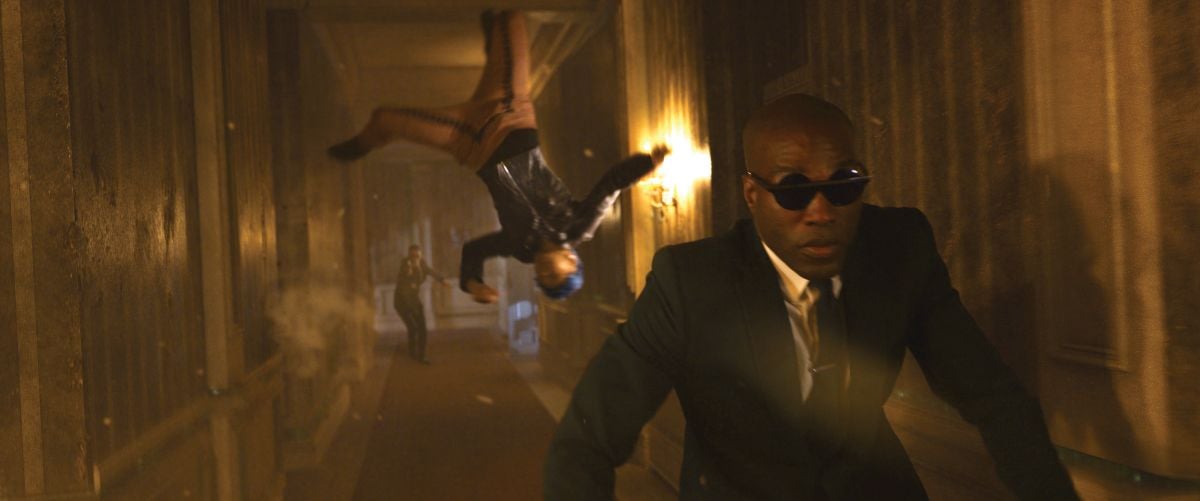
The Matrix Resurrections, which was released in standard and Imax theaters as well as on HBO Max, was shot with spherical lenses and framed for the 2.39:1 aspect ratio. “Early on, we decided to shoot with spherical lenses in the tradition of the [original] trilogy, but also shoot widescreen,” Toll explains. “I’ve never been a fan of an anamorphic, wide-aperture, shallow-depth look. I found the idea of shooting 2.39 widescreen with spherical lenses more appropriate for this film.”
“We tended to use wider focal lengths for traditional coverage,” Toll says. “This usually meant the use of [Panavision Panaspeed] 24mm, 29mm and 40mm lenses. However, Daniele is such an excellent Steadicam operator that I was never hesitant to use long focal lengths on the Steadicam.”
Massaccesi notes that in Berlin he often worked with zooms to help preserve the actors’ energy. “Lana said, ‘We need to be ready for every possible angle,’ he recalls. “Putting the camera down to change lenses slows down the whole process, so the zoom just made everything quicker — do a wide shot, zoom in, the actor says the same line, and you get your close-up. It helped the actors stay in their emotion, and this movie required a lot of emotion.” His main zoom was the Zeiss 28-80mm T2.9 CZ.2, while the Panavision Primo 70 4PZW 28-80mm T3 was the primary B-camera zoom.
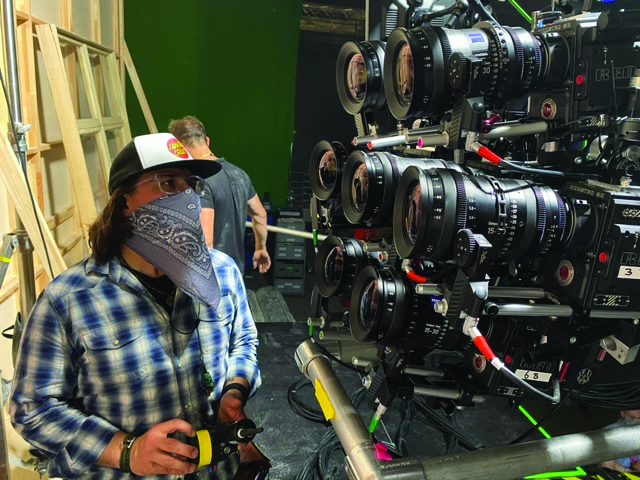
The largest-scale San Francisco night exterior was a wild climactic chase, with Trinity and Neo on a motorcycle evading combative, Matrix-controlled pedestrians, cars, helicopters and explosions. (Some close-up reaction shots of the protagonists were picked up in Berlin.) Smaller Panavision zooms, including the Lightweight Primo LWZ1 T2.8 27-68mm, were put to work in the frenetic sequence.
“Those small zooms were used for some of the handheld camera angles of the motorcycle,” says Rivetti. “They were especially useful to make the camera as small as possible, facilitated by a Panavision backpack system. Basically, we would take everything off the camera that we physically could, and attach it to a backpack — the batteries, wireless follow-focus controllers, CineTape readout controls, and video transmitters were all rigged onto a backpack with 12' cable looms that would run to the camera body. This would minimize the weight of the camera so the operator would have the smallest, most lightweight camera package possible to [move] around the actor. Only the camera body, one focus motor and a small monitor remained — all the other accessories required were on the backpack. The dolly grip would wear the backpack and chase the operator around.
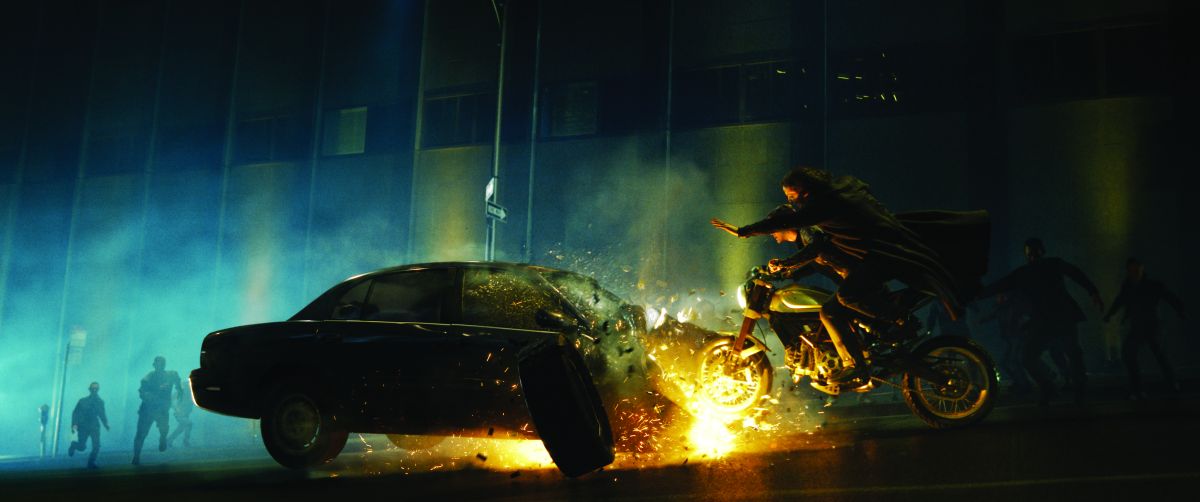
The first film in the Matrix series is well known for the pioneering use of the “bullet time” effect, which captured extreme slo-mo action from a moving perspective, accomplished with an array of 120 still cameras (as described in AC’s 1999 coverage). As production resumed in Berlin, Wachowski wanted to find a way to achieve a similar time-bending effect with a less-involved setup. “We weren’t going to wait two days to get one shot,” Massaccesi notes.
Their new technique came into play in a scene that takes place at a motorcycle-repair shop where Trinity works. The challenge was having actors within the same shot interacting with one another while moving at different speeds. This could have been accomplished by capturing each actor separately in front of greenscreen, but Wachowski wanted to minimize the use of greenscreen in the film, as well as prioritize the energy of actors interacting with each other.
After careful consideration, Massaccesi determined that with a beam splitter 3D rig from 3ality Technica — provided by Red camera supervisor/VFX coordinator Gareth Daley — he could line up two cameras to take the same shot, running one at 120 fps and the other at 8 fps. In post, the two versions of the scene were composited together — using the 8-fps version for the performance of a faster character and the 120-fps version for a slower character. “Bringing the 8-fps shot to 24 fps created a lot of motion blur while the actor was moving, creating the sense he was moving very fast, but he would be sharp when he would stop and talk,” Massaccesi says.
Also paralleling elements of the original trilogy were a number of shots in Resurrections that required the capture of a character from multiple angles at once — for which the filmmakers used a camera array supervised by VFX director of photography Tom Debenham. Scaled-down quite a bit from the setup employed on the 1999 film, the array employed roughly a dozen or so Red DSMC2 Monstro cameras, and sometimes more. “We would change the number of cameras required, depending on the VFX needs for each individual scene,” Rivetti says. The rig was used, for example, for an effect in which Trinity experiences a mid-battle moment of existential fury, as multiple translucent images of herself — each at a different angle yet displaying the same movements — fan out from either side of her.
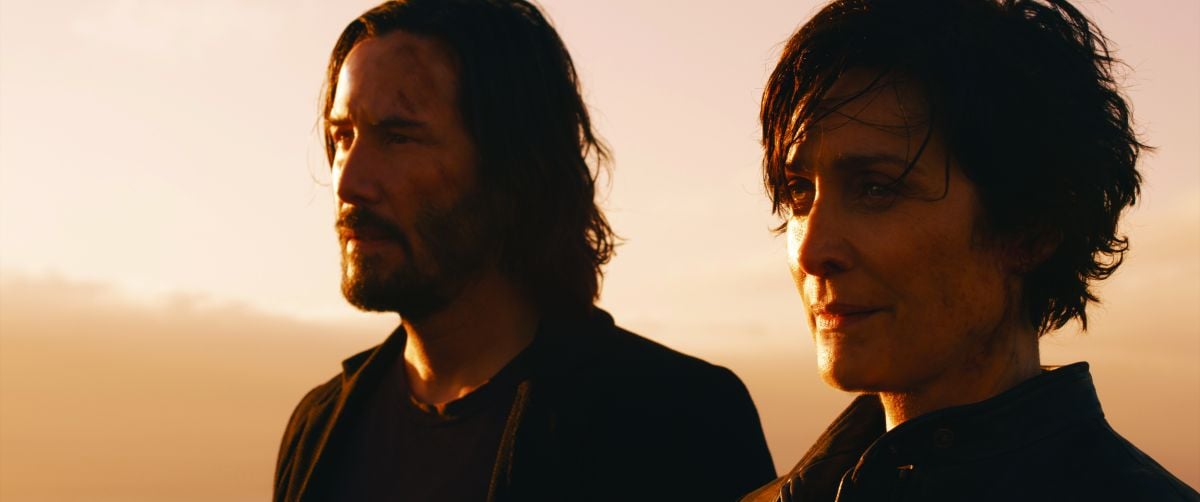
One pivotal moment in the movie sees Neo and Trinity accepting the extent of their powers by taking a running leap off a San Francisco skyscraper at daybreak. The actors themselves performed this wire stunt, jumping from the roof of a 43-story building at 44 Montgomery St., with multiple takes required — rushing back each time to make the most of the early-morning light.
“Enormous amounts of time in prep went into planning and rehearsing this shot and making it safe,” Toll says. “A facility had been set up in Oakland, where details of the stunt work for San Francisco were designed and rehearsed for several weeks with the stunt team. Then Keanu and Carrie-Anne participated, getting comfortable wearing wire rigs and rehearsing the jump.”
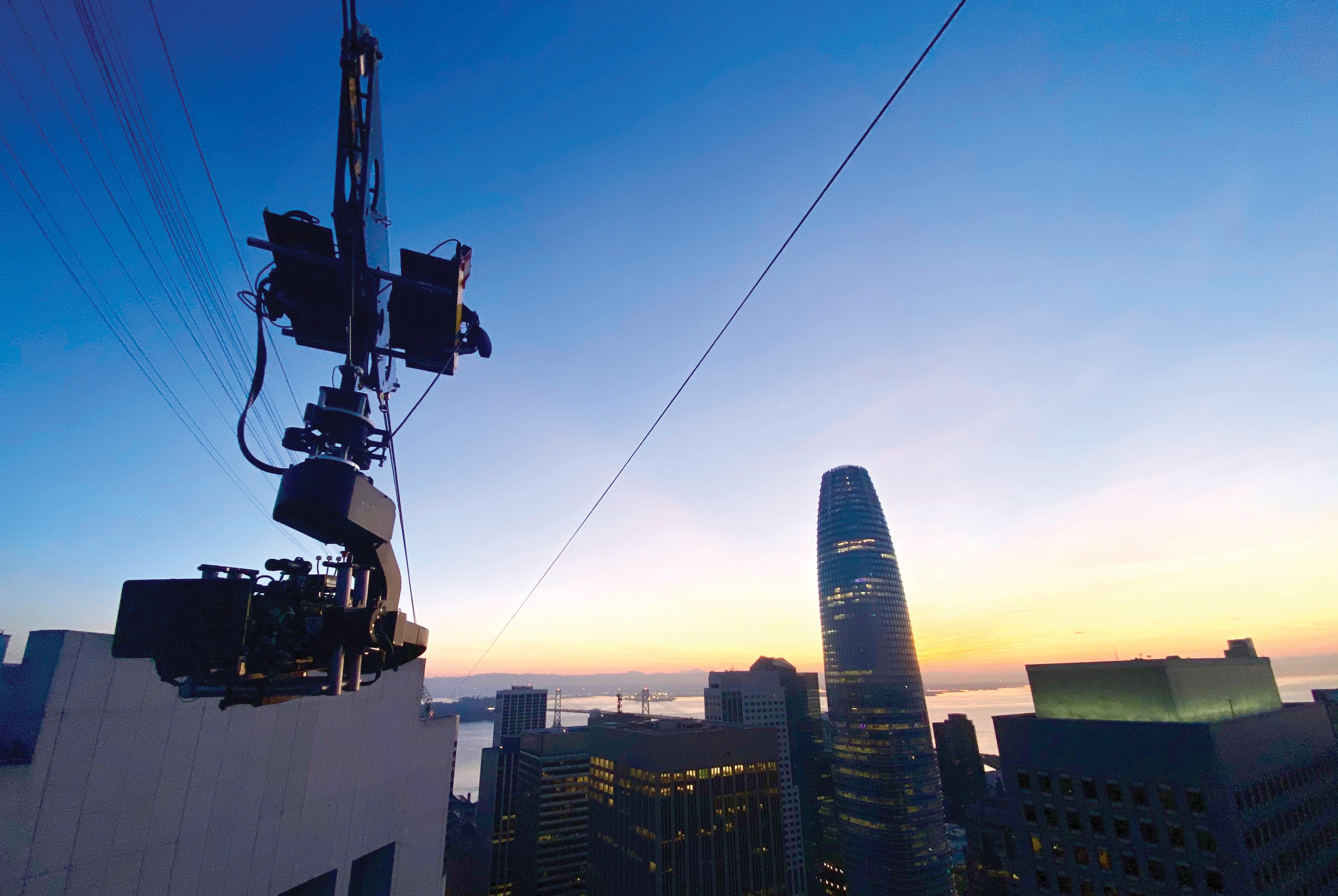
When the sequence was filmed, Toll explains, “The actors were safely rigged on wires strung between buildings. There were four operated cameras: one on a remote head mounted on a separate wire strung between the buildings; one camera on each of the buildings; and one in a helicopter. For all the helicopter work, Dylan Goss served as aerial cinematographer, and Cliff Fleming was aerial coordinator and also the pilot of the camera ship.” Massaccesi operated the A camera on the wire rig, while B and C cameras on the two buildings’ rooftops were operated respectively by Froehlich and George Billinger.
Massaccesi notes that the very short window in which the actors could do the jump in proper lighting was “the 15 minutes after dawn, with the sun just rising over the horizon.” Toll reports that “additional early-morning coverage was required for this sequence, and the jump was repeated more than once on a separate trip.” Adds Massaccesi, “If we knew it was going to be cloudy, we would abort the shot for that day.”
The remote head for the wire-rigged camera was “a Black Unicorn remote head rigged by the stunt department,” Massaccesi says, “which was basically leading the actors as they ran and leaped — starting on a close-up and then widening [as the camera moved farther from the actors]. We couldn’t miss the shot!”






